The world of Dow Theory was abuzz after the Dow Jones Industrial Average and the Dow Jones Transportation Average charged to all-time highs on March 5, 2013 (found here). At the time, the Dow Jones Industrial Average had finally capitulated to the inexorable forces that had long since propelled the Dow Jones Transportation Average above the 2011 all-time high. The confirmation of a Dow Theory bull market came when the Dow Jones Industrial Average finally exceeded the all-time high of 14,164 set in October 2007.
The action of the Dow Industrials and Transports has been so compelling that Dow Theorist Richard Russell acquiesced to the strength of the market on March 11, 2013 by saying the following:
“Yes, I know that this market is uncorrected during its long rise from the 2009 low, and I know that there are risks in buying an uncorrected advance that is becoming uncomfortably long in the tooth, but my suggestion is that my subscribers should take a chance (after all, Columbus took a chance) and take a position in the DIAs.”
In the same posting, Russell later punctuates the point by saying:
“I really believe that subscribers should take a flyer on this market. After all, after weeks of flirting with a new high in the Industrial Average, the Dow finally confirmed the previous record high of the Transportation Average. With the Industrials and the Transports both in record high territory, I think being in the market is justified under Dow Theory.”
By all indications, this Dow Theory bull market indication is the real deal, especially when it is endorsed by Russell’s 55 years of experience on the topic. The implications of this signal are significant for one very important reason, this time we’ve achieved a secular bull market indication (learn about cyclical and secular trends).
Throughout stock market history, cyclical primary bull markets tend to last 2-4 years. These bull markets require rapt attention to the nuances and vagaries of changes in the trend. The last indication of a cyclical primary bull market was on July 23, 2009, when the Dow Industrials traded at 9,069.29. Based on our interpretation of Dow Theory, we received a cyclical primary bear market indication on August 2, 2011 when the Dow Jones Industrial Average was at 11,866.62.
Secular bull markets, on the other hand, require very little attention and have typically lasted between 15 and 18 years. Secular bull markets are the proverbial sweet spot of investing with the trend, where “buy-and-hold” is the rule. The two most prominent secular bull markets resulted in the Dow Jones Industrial Average increasing by 10-fold or more. From 1942 to 1966, the Dow rose from 100 to 1000 and in the period from 1982 to 2000, the Dow went from 1,000 to 11,722. If the current implications are correct, we could be on the cusp of a run to Dow 100,000.
Volume: The Lone Holdout
The three major components of Dow Theory are the Industrials, Transports and trading volume. As described above, the Industrials and Transports have achieved the required all-time highs at (or near) the same time which would indicated that we are in a new cyclical AND secular bull market. However, volume has been the holdout in the current move higher.
In the seminal book on Dow Theory titled The Stock Market Barometer, written by William Peter Hamilton, it says the following about trading volume, “It is worth while to note here that the volume of trading is always larger in a bull market than in a bear market. It expands as prices go up and contracts as they decline.”
The average trading volume for the Industrials and Transports has been in a declining trend (contracting) since the 2009 low, as seen in the charts below.


In order for Dow Theory to have relevance, increasing volume needs to accompany the rise of the stock market to ensure that there is sufficient participation and interest. Unfortunately, average trading volume, as indicated in the above charts for the respective indexes, has been trending lower since 2009. This suggests that we could only be in an extended cyclical bull market, within a secular bear market, rather than at the beginning of a cyclical and secular bull market. The key to understanding trading volume and its interpretation are found in the table below.
| volume |
price |
interpretation |
| decrease |
decrease |
positive |
| decrease |
increase |
negative |
| increase |
decrease |
negative |
| increase |
increase |
positive |
In the days before volume was tabulated for the individual Dow indexes, the New York Stock Exchange trading volume was the proxy for the market trend in conjunction with the Industrials and Transports. Below is the 200-day average trading volume of the NYSE since 2001.

What is evident is the dramatic rise and peak of average trading volume during the decline of the stock market from the peak in 2007 to the bottom in 2009. However, once the market started taking off, the trading volume uncharacteristically plunged. To emphasis the point, below we have included the charts for the cyclical bull markets from 2001-2007 and 2009 to the present.

In the chart from 2001, we can see that NYSE average trading volume hit a peak in 2002 and then flat-lined for a couple of years until 2005. However, as the strength in the stock market grew, the trading volume accelerated to new highs. This was the hallmark of a true bull market run, rising prices and rising volume.

In the chart from 2008, the average trading volume for the NYSE has had a declining trend throughout the whole bull market run from 2009 to the present. As indicated in the table above, declining volume with increasing prices should be interpreted as a negative. After volume has been in a declining trend for so long, the only alternative is for a dramatic increase.
When the increase in volume arrives, the question then becomes, will there be a dramatic increase or decrease in stock market price? Will the general public’s lack of participation be the catalyst that charges the market to move higher? This situation has to be resolved at some point.
To round out our thoughts on the potential secular bull market signal that we recently received, we thought we would compare it to the last secular bull market change in trend. In the period from 1966 to 1982, the Dow Industrials never traded significantly above 1,000. However, that all ended in late 1982 when the stock market broke above 1,000 and never looked back.
Below is a chart of the Industrials, Transports and NYSE trading volume from March 1982 to November 1982:

The most important information to be gleaned from this chart is the fact that all three of the essential indicators for Dow Theory were confirming each other at a critical point in time. They all achieved clear bull market indications by rising in unison. The current divergence between the Dow indexes with the NYSE trading volume suggests that we will be witness to the greatest transition in the history of the stock market.
The above examination of trading volume, based on a what we believe to be reliable sources, has us concerned that a new secular bull market is not really what we’re witness to.
As William Peter Hamilton has said in The Stock Market Barometer:
“The professional speculator is no more superfluous than the pressure gauge of the steam-heating plant in your cellar. Wall Street is the great financial power house of the country, and it is indispensably necessary to know when the steam pressure is becoming more than the boilers can stand.”
The pressure in the market is building and we may be watching the beginning of the most spectacular stock market blow-off ever. Just before an even more astonishing decline.




















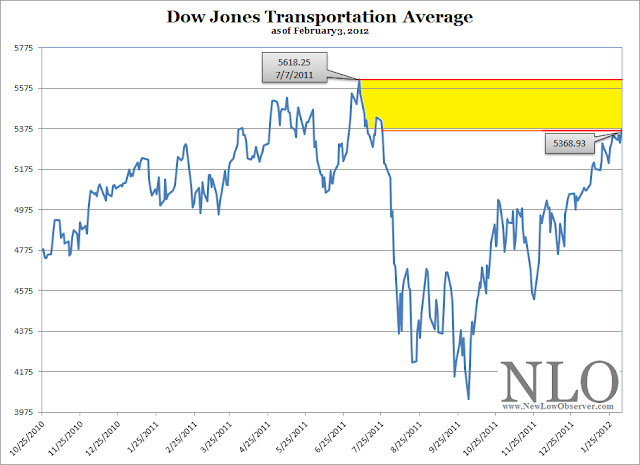
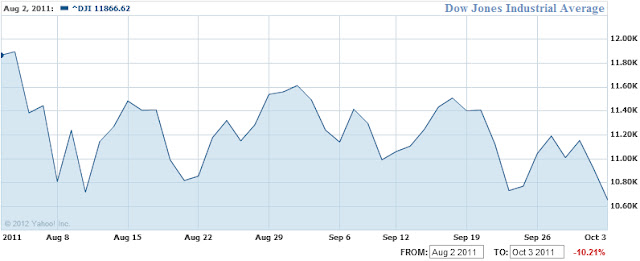
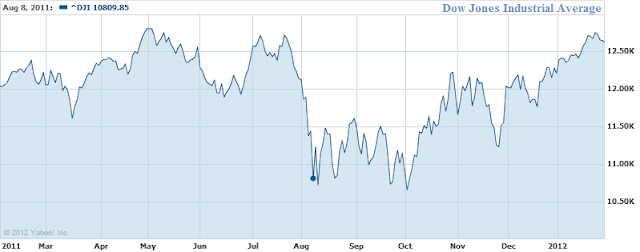
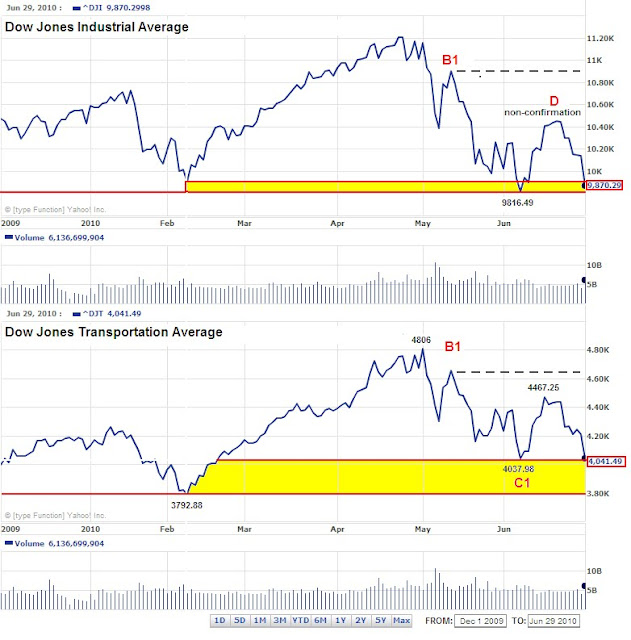
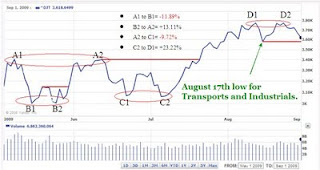 Currently, we're faced with the double top indicated as D1 and D2. From what I can tell, if the decline from D2 goes any further below the August 17th low then we may retrace up to 75% of the gains from C2 to D1. This assessment is based on the prior correction of A2 to C1 from the rise of B2 to A2. On the way down to C2 there are smaller support levels however their significance is not as pronounced as the percentage change from A2 to C1. We should assume the worst case scenario and expect that the Transports will go to 3239.36. Falling to points C1 and B1 would be the next order of operation.
Currently, we're faced with the double top indicated as D1 and D2. From what I can tell, if the decline from D2 goes any further below the August 17th low then we may retrace up to 75% of the gains from C2 to D1. This assessment is based on the prior correction of A2 to C1 from the rise of B2 to A2. On the way down to C2 there are smaller support levels however their significance is not as pronounced as the percentage change from A2 to C1. We should assume the worst case scenario and expect that the Transports will go to 3239.36. Falling to points C1 and B1 would be the next order of operation.